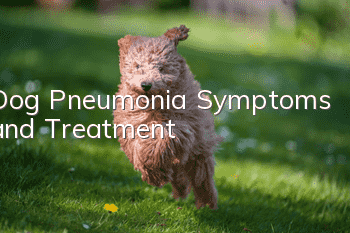Dog Pneumonia Symptoms and Treatment

Due to the current poor air quality, it is easy to cause respiratory diseases, and dogs are also prone to pneumonia. So what are the causes of pneumonia in dogs, what are the symptoms of pneumonia in dogs, and how to treat pneumonia in dogs?
1. Causes of pneumonia
1. Due to colds, stale air, poor ventilation, overwork, and lack of vitamins in the body, respiratory infections and reduced body resistance can lead to microorganisms in or outside the respiratory tract (Staphylococcus, Streptococcus, Escherichia coli, Klebsiella) Bacilli and molds, etc.) After a period of incubation period, the disease attacks, causing the animals to be attacked by the virus.
2. Inhaling irritating gases, soot or ingesting foreign objects that enter the lungs.
3. Continuing factors, such as bronchitis, influenza, canine distemper; or parasites, such as paragonimiasis, Toxoplasma gondii, roundworm larvae, etc. can cause pneumonia.
2. Symptoms of pneumonia in dogs
The disease initially showed symptoms of acute bronchitis, including runny nose, dry cough, and bronchial sounds. As the disease progresses, the general condition worsens, the spirit becomes depressed, the appetite decreases or no food is eaten, the body temperature rises to 39.54 degrees, the symptoms are flaccid fever, dyspnea, increased frequency, conjunctival cyanosis, sunken eyeballs, and dehydration.
During auscultation of the lungs, the alveolar sounds are weakened in the diseased areas, crepitus can be heard, and sounds can be heard in the healthy parts.
Blood changes, total white blood cell count and neutrophils increased, and there was left nuclear shift. X-ray examination shows that the lung texture is thickened and has flaky shadows.
3. Treatment of dog pneumonia
(1) Penicillin 50,000 units/kg body weight, streptomycin 30,000 units/kg body weight, dexamethasone 0.1-0.3 mg/kg body weight, mixed and injected intramuscularly, twice a day, for 5-7 days.
(2) Tetracycline 10-15 mg/kg body weight, dissolved in 5% glucose, intravenously injected, 2 times/day. Or cephalosporin 56 mg/kg body weight, dexamethasone 0.2 mg/kg body weight, mixed intramuscular injection, 2 times/day.
(3) Supportive therapy, 5% glucose saline 15-30 ml/kg body weight, 5% sodium bicarbonate injection 1-2 ml/kg body weight, mixed intravenous infusion.
(4) Fatan antitussive, ammonium chloride 50 mg/kg body weight, Kebiqing 2.5 mg/kg body weight, taken orally 2 times/day. To relieve asthma, aminophylline 10-15 mg/kg body weight can be taken orally 2 times a day.
(5) When you have difficulty breathing and heart failure, take ephedrine orally. 5-15 mg each time. Ammonia teaBase, 10 mg per kilogram of body weight, administered or intravenously, once every 8 hours. For those with difficulty breathing causing hypoxia, oxygen inhalation should be given. For those with anorexia, intravenous injections are given to replenish body fluids and nutrients.
- How to train a golden retriever to sleep on a bed? I’ll teach you a few tips!
- What subjects should Dogo dogs be trained on? Easily teach a good dog!
- There are 3 breeds of Swedish Corgis! Check out Corgi’s “little secrets”
- Dog Tick Symptoms
- Comparison of the advantages and disadvantages of golden retrievers and chow chows
- Super dangerous dog killer: chocolate
- What food is good for Corgi dogs?
- What should I do if my Husky refuses to eat?
- What should I do if my dog keeps hiccups?
- What's wrong with Papillon dogs having diarrhea? Causes and treatments for diarrhea



